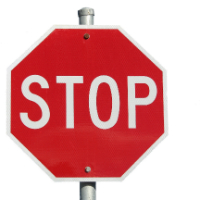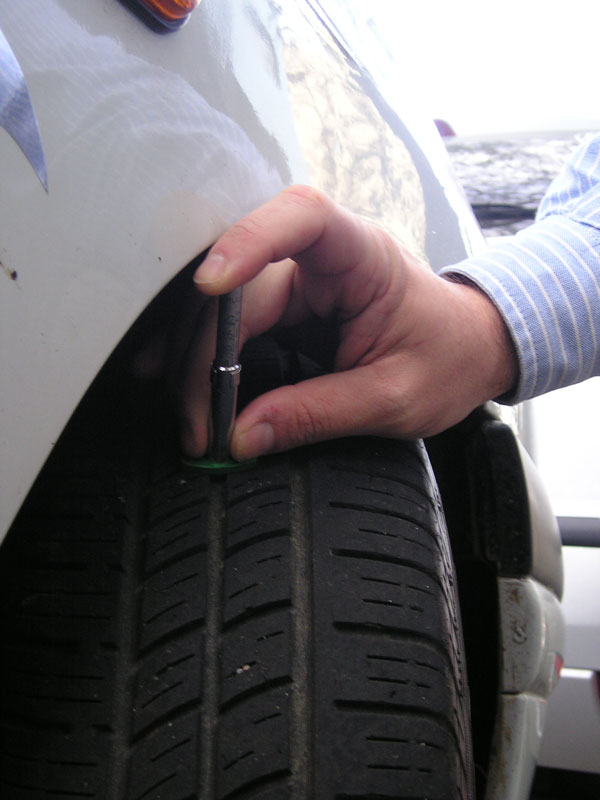 WAIT, BEFORE YOU SCROLL DOWN! While I know a lot about cars, I don't know a lot about YOUR CAR! A repair manual is essential and I have a way for you to get one FREE.
WAIT, BEFORE YOU SCROLL DOWN! While I know a lot about cars, I don't know a lot about YOUR CAR! A repair manual is essential and I have a way for you to get one FREE. Click Here To Read More(Link opens in a new window)
On The Road
Flat Tire?
Stay calm and move to a safe area away from traffic if possible. If you can not reach a pull-off area, call for help and get a tow, it's way to dangerous to change a flat tire close to traffic. Running on a flat tire will ruin the tire and possibly the wheel if you drive on it long enough.
Basic Tire Changing Instructions:
Always consult your owners manual or instructions with your spare tire. Remove spare tire and jack, making sure you have everything you needed to change the tire. Break loose the lugnuts prior to jacking up the car, do not full remove, just loosen an 1/8 of a turn or less. Jack up car at the recommended spot per your owners manual and remove the lug nuts. Put spare in place and tighten lug nuts as much as possible. Lower jack, and fully tighen lug nuts.
Do you have a green cap on your valve stem?
Most likely your tires are filled with Nitrogen. Nitrogen is a larger molecule and expands less than air when heated, making is a perfect gas to fill your tires with. A little more expensive than just filling with air, Nitrogen is becoming more popular. You can add regular air in an emergency without issue, but will eventually lose the benefits of having pure nitrogen in there.
Wheels and Tires

Wheel and tire basics, what you need to know...
When shopping for wheels and tires, most people are in the dark about sizing, tread design and wheel construction. In this section of AutoShop101 we take a look at how you can make an educated buying decision when it comes to buying wheels and tires.
What do the wheels and tires do for your car?
The wheels and tires are your vehicle's connection to the road. This connection effects handling, ride comfort, braking and even fuel efficiency. If you care about looking good while driving down the street, your wheels and tires can also contribute greatly to the look and style of your ride.
Before we look at the mechanics involved, let's look at the construction of the typical wheel and tire.
How are car wheels made?
The majority of wheels on cars and trucks are made from steel or aluminum (also known as alloy wheels). Steel wheels are typically finished off with a plastic hubcap to give the look of a custom alloy wheel. Alloy wheels are typically cast or forged and polished or powdercoated to give a shiny finish to the wheel. Some aluminum and steels wheels are finished off with a chrome finish to leave a bright reflective coating.
When it comes to cost, steel wheels lead the pack with the cheapest purchase price. Cast aluminum wheels are the next more costly option with forged and mag wheels leading the pack of the most expensive wheels out there. In general, the larger the wheel, the more it costs. A 15" steel wheel may be $50 and a 22" chrome plated forged alloy wheel may be as much as $600 per wheel!
How are tires made?
Tires are made from rubber which is molded around a steel and nylon belted core. Under high pressure and heat, the rubber vulcanizes and forms to the tread pattern machined into the mold. Manufacturers vary additives to the rubber compound to effect handling, wet/dry traction and ride quality. The tread pattern is also key to the handling, wet/dry traction and ride quality for a tire. The trick when shopping for tires is to find the best compromise of the factors for your vehicle and driving style. As in life, everything is a compromise, so to get a great handling tire, you may have to give up some ride quality or wet traction. If you want a great tire for wet conditions, you may have to give up dry traction or over all handling.
What can go wrong?
- Flat Tire: A flat tire can ruin your day. Nails, debris and even vandals can flatten a tire when you least expect it. Depending on the damage, the tire can be repaired with a patch or plug. If you have a flat, do not drive longer than needed to get to a safe place to change the tire. Before you have a flat tire, make sure you have a properly inflated spare and that you know the proper procedure for changing a spare tire. Once you have the tire changed, take the tire to a trusted tire shop and have it repaired. When properly repaired, a tire can lead a long and happy life, until the tread wears out.
- Worn Tires:
 Eventually your tires will wear out, it's just a fact of life. If a tire was able to be made to last forever, it would have to be so hard, as to make ride comfort and handling unbearable. All tires have a wear indicator molded into the tread to let you know when it's time to replace your tires. This wear indicator or wear bar runs across the tire and is about 2/32" above the bottom of the tread pattern. When the tread wears down and this wear bar is flush with the top of the tread, it's time to change your tires. If you have a penny handy, you can use it to check your tread depth. From the edge of the penny to the top of Lincoln's head is about 2/32". So if you stick the penny between the tire tread and some of Lincoln's head is not visible then you have more than 2/32" of tread left. Please be aware that misalignment in your suspension can cause uneven wear, so you should check tread depth and both edges of the tire as well as the middle. Proper tire rotation and inflation will keep your tires wearing evenly and prevent premature replacement.
Eventually your tires will wear out, it's just a fact of life. If a tire was able to be made to last forever, it would have to be so hard, as to make ride comfort and handling unbearable. All tires have a wear indicator molded into the tread to let you know when it's time to replace your tires. This wear indicator or wear bar runs across the tire and is about 2/32" above the bottom of the tread pattern. When the tread wears down and this wear bar is flush with the top of the tread, it's time to change your tires. If you have a penny handy, you can use it to check your tread depth. From the edge of the penny to the top of Lincoln's head is about 2/32". So if you stick the penny between the tire tread and some of Lincoln's head is not visible then you have more than 2/32" of tread left. Please be aware that misalignment in your suspension can cause uneven wear, so you should check tread depth and both edges of the tire as well as the middle. Proper tire rotation and inflation will keep your tires wearing evenly and prevent premature replacement. - Bent Rim: It only takes a light hit to a curb while parking to bent a steel or alloy wheel. While steel wheels are a little easier to fix, alloy wheels can take a little more skill. If you have a bent rim, it can effect handling and even cause the tire to leak air over time. Check for local wheel repair shops, and evaluate the cost of repair vs. buying a new wheel.